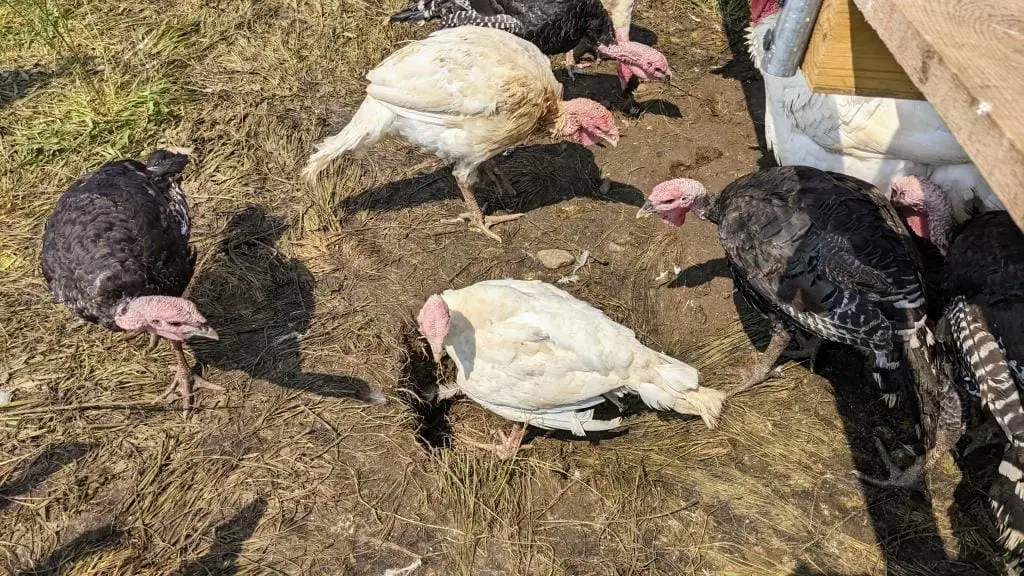Turkeys are surprisingly dedicated diggers. I’ve written before about how they need to eat pebbles to maintain their digestive system, so it makes sense that they have this instinct to excavate. In dry weather, they also wallow in loose dirt after scratching up a divot to make a dust bath. A powdering of dust sifted in among the feathers helps to ward off biting parasites like mites and fleas. This summer has been short on dry weather, so there isn’t much dust bathing going on, and some days it is more like mud bathing…
When the turkeys are pecking, it looks to me like they aren’t just eating pebbles, but it seems like they are also eating the dirt. Their beaks work so quickly that I can’t quite make out what’s going on, but it looks like they are ingesting soil. I’ve seen cattle and pigs doing the same, so I wouldn’t be surprised to learn that the turkeys were eating dirt. It would make sense that soil might be providing them more direct access to minerals than what they might be getting elsewhere in their diets. In some ways this is paradoxical, because a number of harmful turkey diseases are soil-borne. But I suspect that there’s an inoculating effect at work, in which the turkeys are able to expose themselves to the various bacteria and protozoans at low levels and thus to gradually build up a tolerance for diseases that would otherwise prove challenging for turkeys raised in a more artificial setting.
When we move turkeys to a new pasture, they almost always start scratching new holes around the perimeters of larger rocks. I’m not sure of the reason, but the turkeys do it consistently enough for me to think that there must be something special about the soil immediately adjacent to frost-heaved rocks. Maybe as the frost heaves the boulders up through the soil profile it also pushes up a plume of more highly mineralized soil. Or perhaps the soil near the rocks is looser, which just makes it easier to dig. Whatever the reason, the turkeys seem to instinctively search out the bigger rocks that are just peeking out onto the surface.
But despite all that I wrote about digging near big rocks, turkeys have one excavation situation they favor even more. Turkeys especially love when another animal has started a hole for them. This week we moved them into a patch of pasture in which a groundhog had recently dug a burrow. Groundhog dens always have at least two entrances, so two groups of turkeys were at work on the project. By the end of the first day they were already more than a foot down, pecking and clawing their way through the ground. The second day we had some heavy rain, so the birds only managed to trample the holes into a muddy mess. We moved them to a new pasture by the next the morning, leaving the birds to find a new place to start digging.

For my own comfort of wanting to walk across a pasture without my foot plunging into an ankle-twisting hole, I sometimes selfishly wish that turkeys (and groundhogs) would just leave the ground alone. But when I take the time to observe them tirelessly pecking away at a new ditch, I’m always pleased to see how turkeys manage to be turkeys. And I think that ties into a critical aspect of our task as farmers – managing the situation so that each group of livestock can embody their identity as fully as possible. If turkeys are diggers, we’ll be doing a better job as farmers if we figure out how to allow them to express those instincts and to get digging.

6 thoughts on “Tunneling Turkeys”
Perhaps there are some bugs that like to hide in the crevice between rock and soil that are food for the turkeys.
Yes, it may be that bugs down in the dirt are part of the story too.
Interesting article with a little humor mixed in! Thanks for all your articles!
Thanks!
Turkeyness of turkeys. It sounds like you’re doing a little Salatin quoting you know “the pigness of pigs”. Love watching how God’s designs play out in His creation. Especially rewarding when it’s the part of creation that you’re giving stewardship over.
I wonder if maybe the rocks themselves have just weathered enough in the vicinity of that rock to raise the mineral content of the soil directly adjacent to them which I imagine would be very attractive to the turkeys.
Yes, I agree that weathering may have something to do with it.